But the fact is, most military (and civilian) vehicles are simply too large to be practical as mass-market items in true 1/6th scale. An F-22 Raptor scales over ten feet long. An M1A1 Abrams tank would be over five feet long and two feet wide. A Chinook cargo helicopter (including rotors) would be sixteen and half feet long! You aren't going to find these on the shelves at Wal-Mart any time soon. So something has to give. Either the vehicles have to be made smaller than scale, or they don't get made at all.
Fact is, shrunken vehicles are part of the great history of our hobby. Yet there's more than one way to shrink a vehicle, as we'll soon see. Other than just anal attention to scale, one of the major complaints about the not-quite 1/6th vehicles I mentioned above is that they didn't work well with figures. Pilots have to be jammed into the front of the Little Bird (which didn't even have room to include the pedals). The M8 really doesn't have room for a driver with legs attached, and troops don't fit well in the Bradley.
Fact is, near as I can tell, these vehicles are more or less scale, just not the scale people wanted. They were reduced, in all dimensions, to fit some arbitrary specification (to fit a box, or to be produced at some price point, or to fit a shelf, or to be shippable).
But that isn't the only way to do things. The other way, the better way I think, is "selective compression." Selective compression reduces dimensions individually with an eye to both the requirements and the intended use. For instance, if the goal is to make a vehicle fit in a box 48" long, the engine compartment might be reduced in size, leaving the cab area unchanged and large enough for a full-scale figure. Of the dimensions of the vehicle might all be reduced, and then the roof-height increased enough so the figure will fit.
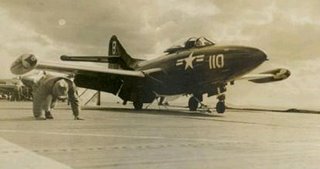
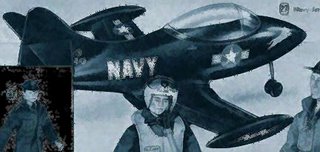
When done well, one can hugely change the dimensions of a vehicle and still capture "look and feel" of the original. One classic example, even if it takes things to extremes, is the vintage Irwin Panther jet airplane seen below, along with the real-life Grumman Panther jet on which is it based.
Mind you, not a single dimension or line of the jet remains unchanged. In fact, a scale Panther jet would have a length and wing-span both over six feet! I don't have the dimensions of the Irwin Jet, but I'd guess it's under a third of that. Yet there is no doubt that one plane is based on the other. Irwin designers boiled the panther down to a form that preserved its essence, but that a child could pick-up and fly around the room. On top of that it would hold (just barely) a 1/6th GI Joe figure.
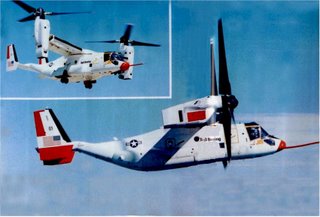
Let's try applying these principles to a modern military vehicle that seems very Joe-worthy, the V-22 Osprey tilt-rotor. The Osprey is a cutting-edge hybrid vehicle combining some of the best features of a helicopter and a fixed-wing cargo airplane. It can fly rapidly and smoothly to a distant target, hover or land vertically to deploy or recover troops, and then fly rapidly back to base. It's an ambitious aircraft that's had it's share of problems, but if the bugs can be worked out its truly revolutionary.
Trouble is, for Joe purposes, it's just way too big. Each rotor alone would be over six-feet in diameter! The fuselage would be nearly six feet long. The span, including rotors, would be almost 14 feet! Young Hercules himself couldn't lift this monster and fly it around the room, even if he had a room big enough.
So, how to make a "kid friendly" version that would fit Joe and still be recognizable ? Well, my first move is to drop the V-22 entirely, and go to its predecessor, the experiment XV-15. Though the two vehicles look a lot alike, the XV-15 is already 20% smaller. Still not nearly small enough, but that 20% is something we don't have to cut.
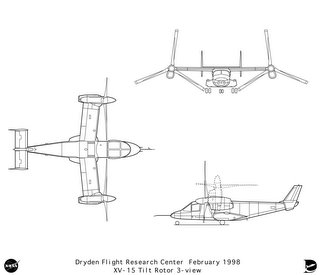
Here's a 3-view drawing of the XV-15, courtesy of NASA. I used this (specifically, the top view) as the basis of my compression. My first move was to load it into my paint program and chop it into individual parts: cockpit, wings, rotors, tail-cone, tail surfaces, rotors.
Then I started eliminating anything that wasn't necessary. The straight sections of the fuselage fore and aft of the wing were cut out and discarded. The tail was still too long, so I shortened it a bit, and then shrunk the tail surfaces. The wings were made smaller as well. The engines weren't reduced quite as much, but the rotors were made much smaller. The original V-22 has a large cockpit for two flight crew sitting side by side, but I'm assuming the Joe version will have a single seat in the middle. Suddenly, things overall can be MUCH smaller.

What's left still has the recognizable flavor of the V-22, but it's a fraction of the size, I'm guessing about three-feet long. That's still big by kid-standards, but perhaps not impossibly so. (A Sigma-6 or 3 3/4" version would make a very attractive retail product.) The tail and wings would be removable for storage (or for the retail box).
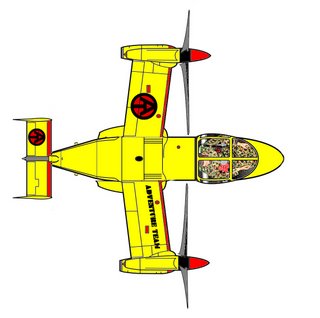
Of course, by now the question that must be burning in all your brains is, "Steve, what does the Adventure Team version look like? Glad you asked...
What's the point of all this, designing a toy that will never be made for a line that no longer exists? I'm not sure, really, except that it's in the spirit of the toys I loved as a kid. Maybe I can't be ten again, and find this thing under my Christmas tree, but I can at least imagine...
1 comment:
cool post, well done.
-V-22 designer
Post a Comment